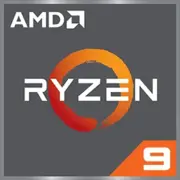AMD Ryzen 9 PRO 3900

AMD Ryzen 9 PRO 3900: Power and Stability for Professionals
Analysis of a processor that remains relevant even in 2025
Key Specifications: Architecture, Process Technology, and Key Features
Zen 2 and TSMC 7nm Technology
The AMD Ryzen 9 PRO 3900 is built on the Zen 2 architecture, which, despite the release of newer generations (Zen 4, Zen 5), remains relevant due to optimization for workloads. The TSMC 7nm FinFET process offers a balance between performance and energy efficiency: 12 cores and 24 threads operate at a TDP of only 65W.
Performance:
- Geekbench 6 Single-Core: 1655 (comparable to Intel Core i7-12700K).
- Multi-Core: 8863 — sufficient for rendering 3D scenes or compiling code.
- 64 MB L3 cache accelerates processing of large data (e.g., in CAD or when working with databases).
Key Features:
- AMD PRO Technologies: Hardware protection from threats (Secure Processor, Memory Guard), support for remote management.
- ECC Memory: Critical for workstations where memory errors are unacceptable.
- Energy Efficiency: Even under load, the processor rarely exceeds 80°C with the stock cooler.
Compatible Motherboards: Sockets and Chipsets
Socket AM4: A Proven Platform
The Ryzen 9 PRO 3900 uses the AM4 socket, which dominated the market from 2017 to 2023. This means a wide selection of used boards, but new models in 2025 are already rare.
Recommended Chipsets:
- X570: Supports PCIe 4.0, overclocking (although the PRO version is limited in this), and two NVME slots. Example: ASUS TUF Gaming X570-Plus ($150–180).
- B550: Budget option with PCIe 4.0 for graphics cards and one storage device. Example: MSI B550 Tomahawk ($120–140).
Selection Considerations:
- VRM: For stable operation of a 12-core processor, a board with at least 8-phase power is needed (e.g., Gigabyte X570 Aorus Elite).
- BIOS: Be sure to update the firmware — early versions may not support the PRO series.
Supported Memory Types: DDR4 and Nuances
Only DDR4: Speed and Capacity
The processor works with DDR4, which in 2025 seems outdated against the backdrop of DDR5, but remains beneficial:
- Official Support: Up to 3200 MHz (overclocking to 3600–3800 MHz is possible on X570 boards).
- Recommended Capacity: 32 GB (2×16 GB) for 4K video editing or 64 GB (4×16 GB) for virtualization.
Examples:
- Kingston Fury Renegade DDR4-3600 32GB (~$120) — low latency (CL16).
- Important: Activating ECC requires support from the motherboard (e.g., ASUS Pro WS X570-ACE).
Power Supplies: Calculation and Recommendations
TDP 65W — Does Not Mean "Weak"
Although the processor is efficient, a system with a discrete graphics card consumes more:
- RTX 4070: ~200W.
- SSD, Fans: +50W.
Recommendations:
- Minimum: 550W (e.g., Corsair CX550M, $60).
- Optimal: 650–750W with headroom for upgrades (Seasonic Focus GX-650, $100).
- Certifications: 80 Plus Gold for efficiency >90%.
Pros and Cons: Who It Is For and Who It Is Not
Advantages:
1. Performance/Watt: Best in class for 12-core CPUs.
2. Reliability: PRO series protection reduces risks of failures in work tasks.
3. Quiet Operation: Even under load (thanks to low TDP).
Disadvantages:
1. Outdated Platform: No PCIe 5.0 and DDR5.
2. Price: New units in 2025 cost $320–370 — more expensive than AM5 equivalents.
3. Lack of Overclocking: PRO models are locked for overclocking.
Usage Scenarios: Gaming, Work, Multimedia
Workstations:
- 3D Rendering (Blender): Comparable to Ryzen 9 5900X but with lower heating.
- Virtualization (VMware): 24 threads allow running multiple OSs simultaneously.
Gaming:
- 1080p/1440p: Adequate for RTX 4070 (Cyberpunk 2077 — 90+ FPS on high settings).
- 4K: Bottleneck is the graphics card, not the CPU.
Multimedia:
- Premiere Pro: Rendering a 30-minute 4K project in ~12–15 minutes.
- Streaming: NVENC of the graphics card reduces the load on the CPU.
Comparison with Competitors
AMD Ryzen 9 3900X:
- Pros: Higher base clock (3.8 GHz vs 3.1 GHz), unlocked multiplier.
- Cons: TDP 105W, no ECC or PRO protection. Price: ~$280 (used).
Intel Core i7-13700:
- Pros: DDR5, PCIe 5.0, higher IPC.
- Cons: More expensive ($380), 16 cores (8P+8E), ECC only in Xeon versions.
Build Tips: How to Avoid Mistakes
1. Cooling: Even the BOX cooler is sufficient, but for quiet operation choose a tower cooler (DeepCool AK400, $35).
2. Memory: 2 DDR4-3600 modules instead of 4 — for more stable operation.
3. SSD: Ensure NVMe (Samsung 980 Pro 1TB, $90) — PCIe 4.0 will unlock speed.
4. Case: A minimum of 2 fans for ventilation (e.g., NZXT H510 Flow).
Final Conclusion: Who Is Ryzen 9 PRO 3900 For?
This processor is the choice for those who value:
- Stability: For workstations where failures are unacceptable.
- Energy Efficiency: Servers or PCs running 24/7.
- Budget: Cheaper than new AM5 models but with sufficient power.
Not Suitable For: Gamers wanting maximum FPS in CS2, or enthusiasts needing PCIe 5.0 and DDR5.
Target Audience: IT companies, engineers, video editors, and anyone needing a reliable 12-core processor without overpaying for "gimmicky" features.
Prices are valid as of April 2025. Listed for new devices at retail in the USA.
Basic
CPU Specifications
Memory Specifications
GPU Specifications
Miscellaneous
Benchmarks
Compared to Other CPU
Share in social media
Or Link To Us
<a href="https://cputronic.com/en/cpu/amd-ryzen-9-pro-3900" target="_blank">AMD Ryzen 9 PRO 3900</a>